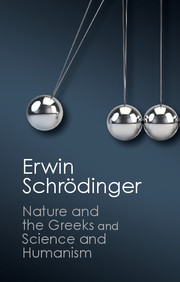Book contents
- Frontmatter
- Contents
- Foreword
- NATURE AND THE GREEKS
- SCIENCE AND HUMANISM
- Dedication
- Preface
- The spiritual bearing of science on life
- The practical achievements of science tending to obliterate its true import
- A radical change in our ideas of matter
- Form, not substance, the fundamental concept
- The nature of our ‘models’
- Continuous description and causality
- The intricacy of the continuum
- The makeshift of wave mechanics
- The alleged break-down of the barrier between subject and object
- Atoms or quanta-the counter-spell of old standing, to escape the intricacy of the continuum
- Would physical indeterminacy give free will a chance?
- The barto prediction, according to Niels Bohr
The nature of our ‘models’
Published online by Cambridge University Press: 05 October 2014
- Frontmatter
- Contents
- Foreword
- NATURE AND THE GREEKS
- SCIENCE AND HUMANISM
- Dedication
- Preface
- The spiritual bearing of science on life
- The practical achievements of science tending to obliterate its true import
- A radical change in our ideas of matter
- Form, not substance, the fundamental concept
- The nature of our ‘models’
- Continuous description and causality
- The intricacy of the continuum
- The makeshift of wave mechanics
- The alleged break-down of the barrier between subject and object
- Atoms or quanta-the counter-spell of old standing, to escape the intricacy of the continuum
- Would physical indeterminacy give free will a chance?
- The barto prediction, according to Niels Bohr
Summary
In this we must, of course, take shape (or Gestalt) in a much wider sense than as geometrical shape. Indeed there is no observation concerned with the geometrical shape of a particle or even of an atom. It is true that in thinking about the atom, in drafting theories to meet the observed facts, we do very often draw geometrical pictures on the black-board, or on a piece of paper, or more often just only in our mind, the details of the picture being given by a mathematical formula with much greater precision and in a much handier fashion than pencil or pen could ever give. That is true. But the geometrical shapes displayed in these pictures are not anything that could be directly observed in the real atoms. The pictures are only a mental help, a tool of thought, an intermediary means, from which to deduce, out of the results of experiments that have been made, a reasonable expectation about the results of new experiments that we are planning. We plan them for the purpose of seeing whether they confirm the expectations—thus whether the expectations were reasonable, and thus whether the pictures or models we use are adequate. Notice that we prefer to say adequate, not true. For in order that a description be capable of being true, it must be capable of being compared directly with actual facts. That is usually not the case with our models.
- Type
- Chapter
- Information
- 'Nature and the Greeks' and 'Science and Humanism' , pp. 125 - 130Publisher: Cambridge University PressPrint publication year: 2014



